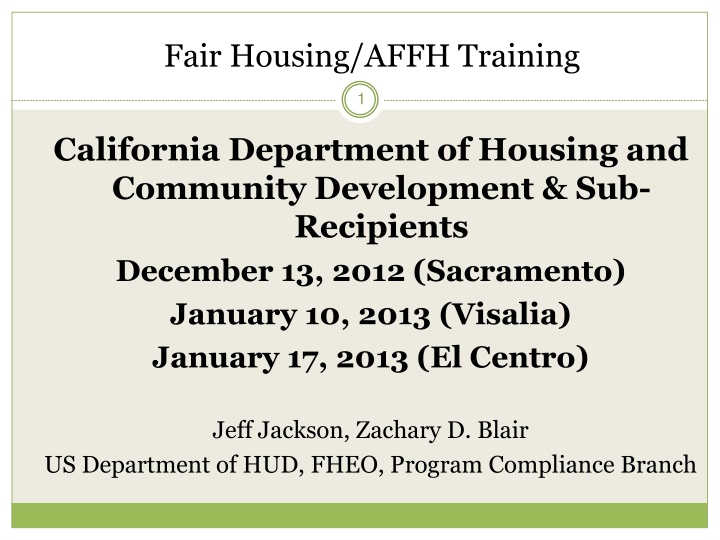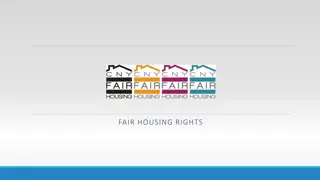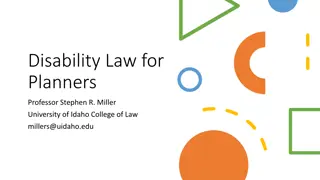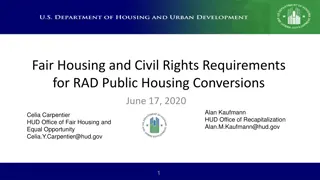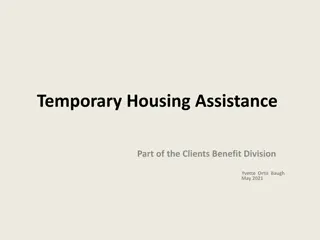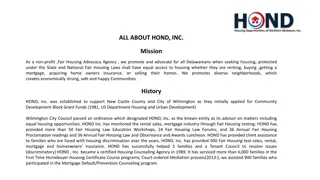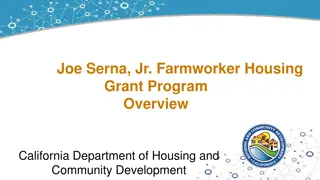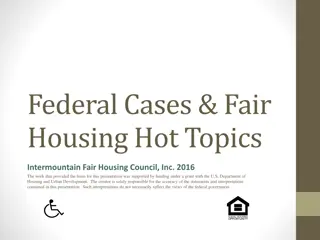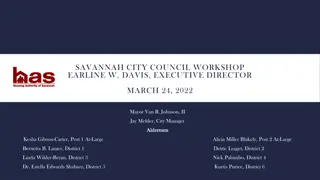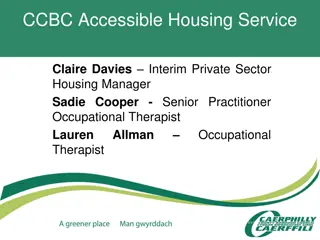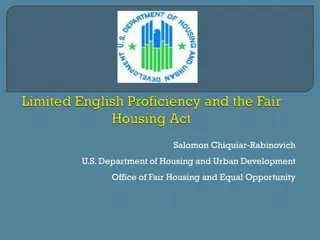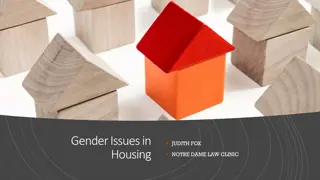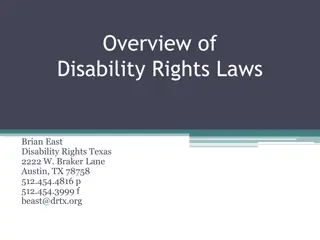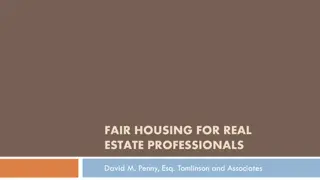Fair Housing Laws Overview and Compliance Requirements
This content provides an in-depth overview of federal and California fair housing laws, including obligations for housing providers and recipients/sub-recipients. It covers topics such as Affirmatively Furthering Fair Housing, Section 504-ADA considerations, Limited English Proficiency, Equal Access to Housing, and more. The Federal Fair Housing Act prohibits discrimination based on various factors, ensuring equal opportunity for all individuals in housing programs.
Download Presentation

Please find below an Image/Link to download the presentation.
The content on the website is provided AS IS for your information and personal use only. It may not be sold, licensed, or shared on other websites without obtaining consent from the author.If you encounter any issues during the download, it is possible that the publisher has removed the file from their server.
You are allowed to download the files provided on this website for personal or commercial use, subject to the condition that they are used lawfully. All files are the property of their respective owners.
The content on the website is provided AS IS for your information and personal use only. It may not be sold, licensed, or shared on other websites without obtaining consent from the author.
E N D
Presentation Transcript
Fair Housing/AFFH Training 1 California Department of Housing and Community Development & Sub- Recipients December 13, 2012 (Sacramento) January 10, 2013 (Visalia) January 17, 2013 (El Centro) Jeff Jackson, Zachary D. Blair US Department of HUD, FHEO, Program Compliance Branch
Presentation Overview 2 Overview of Fair Housing Laws Affirmatively Furthering Fair Housing a recipient/sub-recipient s obligations, and what FHEO looks for in compliance reviews Affirmative Fair Housing Marketing Plans Section 504 - ADA Olmstead Considerations Limited English Proficiency Equal Access to Housing in HUD Programs Regardless of Sexual Orientation or Gender Identity Section 3 Obligations
Overview of Fair Housing Laws 3 Federal Fair Housing Act California Fair Employment & Housing Act ibid. Apply to virtually all housing providers Title VI of the Civil Rights Act of 1973 Section 504 of the Rehabilitation Act of 1973 Apply to federally funded housing Does not apply to private housing or HCVs Americans with Disabilities Act (ADA) Title II applies to state or local government housing Title III applies to commercial facilities and public accommodations (Rental offices, childcare centers, community rooms areas that are available for public use
Federal Fair Housing Act 4 Prohibits housing providers from discriminating on basis of Requires HUD to administer its programs in such a way as to ensure equal opportunity to participate, without regard to an applicant s or beneficiary s Race Color National origin Religion Sex Familial status (people with minor children) Disability (physical, mental, developmental) (a) (b) (42 USC 3608(e)(5); 24 USC 100, et seq.)
Federal Fair Housing Act 5 Applies to virtually all housing providers, both public and private Prohibited Activities include (non-exhaustive list): Refusing to sell, rent, deal Differential terms & conditions of tenancy Discriminatory statements False representation of availability Denial of reasonable accommodation/modification Discrimination in terms of mortgage lending Discrimination in terms of property insurance
California Fair Employment & Housing Act 6 Enforced by California Department of Fair Employment & Housing (DFEH) Applies to all housing providers, whether or not federally-funded (with minor exemptions) Includes all 7 federal protected classes, plus prohibiting discrimination on additional bases of: Marital status Age Sexual orientation/gender identity Source of Income *Other arbitrary bases
Title VI of the Civil Rights Act of 1964 7 Prohibits recipients of HUD funding from discriminating on the basis of, or using methods of administration thathave the effect of limiting or denying participation, on the basis of: Race Color National origin (24 CFR 1, et seq.)
Section 504: New Construction 8 Multifamily projects of 5/+ units Minimum of 5%* units accessible to persons with mobility impairments (not fewer than 1) Minimum of 2%* units accessible to persons with hearing or vision impairments (not fewer than 1) Should include similar range of sites and bedroom sizes and amenities as other units of program. *HUD may require higher percentage if demonstrated need. (24 CFR 8.22, 8.25, 8.26, 8.27)
End of Overview on Fair Housing Laws 9 Questions?
Affirmatively Furthering Fair Housing Choice in HUD Programs 10 Where does the requirement originate? What does the term AFFH mean? To which programs does it apply? What are a recipient s obligations? What are HUD staff s monitoring obligations?
Legal Authority to AFFH 11 Section 808 (e) (5) of the Fair Housing Act The Secretary shall administer the programs and activities relating to housing and urban development in a manner affirmatively to further the purposes of the Act. (42 USC 3608(e)(5)) In varying ways, AFFH requirements apply to all HUD programs (CPD, PIH, Housing, FHEO) Program-specific AFFH requirements & obligations are found in individual program regulations
What is Fair Housing Choice? 12 The ability of persons, regardless of race, color, religion, sex, disability, familial status or national origin, to have available to them the same range of housing choices.
General Goals of AFFH 13 Affirmatively Furthering Fair Housing Choice = a comprehensive strategy designed to: Reduce Housing Discrimination Promote public awareness of fair housing laws and rights Ensure a broad range of affordable housing opportunities Ensure the accessibility of housing to persons with disabilities
Affirmatively Furthering 14 Does NOT mean establishing quotas. DOES mean: Conducting analysis to identify groups least likely to participate (including development of AI) Undertaking affirmative marketing and outreach to promote participation by least likely groups Taking actions to overcome patterns of segregation or concentration Eliminating methods of administration which may have effect of discrimination
Anti-Discrimination Center of Metro NY v. Westchester County, NY 15 United States ex rel., Anti-Discrimination Center v. Westchester County, NY (USDC Southern NY 06-cv-2860) County conducted no analysis of racial/ethnic segregation County permitted long-term pattern of affordable housing development almost exclusively in areas of racial/ethnic minority concentration County s annual certifications of compliance with requirement to affirmatively further were determined to be false claims Settlement: $62.5 M + development of 750 new housing units in non-minority areas + affirmative marketing
Anti-Discrimination Center of Metro New York vs. Westchester County, NY 16 County received $52M in CDBG, HOME, ESG funds from 2000-2006 40% of consortium municipalities have Black populations of 1% or less 60% of consortium municipalities have Black populations of 3% or less A few municipalities (Yonkers, New Rochelle, Mt. Vernon, White Plains, Peekskill, Greenburgh) have Black populations of 16% or more (courtesy of Attorney Michael Allen)
Westchester County, NY (courtesy of Attorney Michael Allen) 17
Westchester County, NY 19 Placement of Affordable Housing Areas of Racial Concentration
Discussion of Westchester Case 20 Virtually all affordable housing built in areas of existing minority concentration Few new affordable housing planned or built outside of areas of minority concentration Westchester county allowed richer, predominately- White municipalities to opt out of affordable housing development
Discussion of Westchester Case 21 2000 & 2004 Analysis of Impediments described the unmet housing needs of persons with disabilities and families with children as impediments, but did not identify any racial or ethnic factors, such as lack of affordable housing outside of areas of minority concentration, as an impediment Annual certifications made to HUD as condition of funding that it had undertaken actions to affirmatively further fair housing choice
AFFH: Recipient Obligations (all programs) 22 Consider how laws, regulations and administrative procedures can affect: Location Availability Accessibility of Housing Conduct assessment of conditions that could adversely affect fair housing choice
AFFH Actions in CPD-funded programs 23 Regulatory Requirements for CDBG/HOME programs: Meaningful citizen participation in planning processes (24 CFR 91.100) Conduct Analysis of Impediments to FH choice (AI)(24 CFR 91.225 + Fair Housing Planning Guide Volume I) ConPlan/AAP activities to address impediments (ibid) Data collection, monitoring & ongoing analysis by recipients/sub-recipients to identify underserved persons (24 CFR 121, 91.205, 91.225, 91.305, etc.)
AFFH Actions in CPD-funded programs, contd. 24 Development of housing that includes choices outside of areas of concentration (24 CFR 91.220, 92.202) Outreach & marketing to underserved persons (Title VI, Section 504 general regs) Analysis of special needs of persons with LEP (Title VI regs, 1/22/07 LEP Notice) Physical accessibility of meeting sites & funded activities, including housing (Section 504 regs at 24 CFR 8.20, et seq.) Sign certification that recipient will AFFH (24 CFR 91.225, 91.325)
The Fair Housing Planning Guide 25 Available online: http://portal.hud.gov/hudportal/documents/huddo c?id=fhpg.pdf Update as part of recipient s ConPlan cycle, or as changes to conditions/impediments occur (e.g., new census shows increase in minority population) Provides structure for areas to be analyzed Provides a list of sources of data Meaningful public participation is essential
The Fair Housing Planning Guide, contd. 26 Lack of affordable housing is not necessarily, by itself, an impediment to fair housing choice Lack of affordable housing is an impediment when an analysis of disproportionate need identifies specific racial or ethnic groups, disabled, female-headed households, families with children as having relatively greater unmet need for affordable housing than general population AI must analyze patterns of racial/ethnic concentration if affordable housing is primarily in existing areas of racial/ethnic concentration, that must be identified as an impediment. Impediments must be addressed with remedial actions in ConPlan/AAP!
What HUD looks for in a compliance review 5 areas 27 1. Meaningful public participation in development of AI, ConPlan, AAP Nothing speaks louder than zero! Outreach to promote public participation by service agencies, advocates, affected public, with affirmative outreach to least likely groups LEP outreach, reasonable accommodations Day of week, times, places of public meetings Response to public input Transparent funding decisions & prioritization
What HUD looks for in a compliance review 5 areas 28 2. What impediments identified in AI, can HUD identify other impediments not addressed? Does any jurisdiction really have no impediments ? Data, coordination, input from local PHA Analysis of disproportionate need for 7 protected classes Accessible housing for disabled persons Special needs of families with children Transportation, employment, educational and other cost of living impediments FH enforcement data from HUD, DFEH, private fair housing agencies
What HUD looks for in a compliance review 5 areas 29 3. Has recipient addressed impediments, are protected groups benefitting? Can each impediment be linked to a remedy or action in the ConPlan, AAP, CAPER? Did recipient establish measurable goals? Did recipient collect & analyze participation data, employ affirmative outreach/marketing, revise if original efforts were not effective? Did recipient respond to FHEO concerns in review of prior year s AAP, CAPER, compliance review/VCA?
What HUD looks for in a compliance review 5 areas 30 4. Has recipient s development of affordable housing included choices outside of areas of concentration*? People should have a right to a range of choices about where they live Consider all types of affordable housing, not just that created or preserved with HUD funding What percentage has been created outside of areas of concentration?
What HUD looks for in a compliance review 5 areas 31 4, continued: What constitutes an area of racial or ethnic concentration ? No firm definition in program regulations Our office uses Section 202/811 definitions: Any one minority >20% above same minority in HMA, or All minorities combined >20% above all minorities in HMA, or All minorities combined >50% of total population in urban area
What HUD looks for in a compliance review 5 areas 32 5. Have protected classes benefittedfrom recipient s development of affordable housing? Data collection & analysis for all types of affordable housing, not just HUD-funded. Does recipient have data collection methodology? Has data been analyzed vis- -vis participation rates? Did recipient affirmatively market to least likely or under-represented protected groups? Did recipient include accessible housing for disabled? Did recipient accurately report participation in IDIS or CAPER narrative, explain actions taken to promote participation by under-represented groups?
What HUD looks for in a compliance review 33 What data should recipients & sub-recipients collect to fulfill obligation to affirmatively further fair housing choice? 2002 OMB Standards for Federal Data on Race and Ethnicity: HUD Policy Statement and Implementing Guidelines HUD Forms 50058/50059 race, ethnicity data Sex, familial status data Disability data (need for accessible housing as distinct from status as a disabled person)
CPD Programs What would YOU do? 34 A city CDBG/HOME recipient claims in its AI that there are no impediments to fair housing choice anywhere in its jurisdiction A city CDBG/HOME recipient claims it advertised its AAP planning process, but that no citizens attended the meeting and so no public commentary was received
CPD Programs What would YOU do? 35 A state or county CDBG/HOME recipient claims that it s just a pass through funding source , and that the sub-recipients/grantees are solely responsible for collecting and analyzing the data to determine if housing is built in areas of concentration, or if protected classes are participating in representative percentages funded activities
CPD Programs What would YOU do? 36 A county has been awarded NSP 3 funding, and plans to use its funding for acquisition/rehabilitation/resale of single-family homes in an area with a very high foreclosure rate. The area is also racially- and ethnically- concentrated
CPD Programs What would YOU do? 37 Data supplied by HUD indicates that 20 complaints of housing discrimination have been filed in a CDBG/HOME recipient s service area over past 3 years. Based upon this: Should housing discrimination be identified as an impediment in this recipient s AI? Should this recipient fund a private fair housing agency to provide fair housing services, including testing, auditing, enforcement, education and outreach, to address this impediment?
CPD Programs What would YOU do? 38 Analyzing housing discrimination complaint data: City A 494,665 City B 53,967 City C 95,631 City population # FH complaints (5 years) 59 (avg 12/year) 12 (avg 2.4/ year) 10 (avg 2/year) Complaints/ rental transactions FH problem? 12/33,000 2.4/3,600 2/6,400 (.04%) (.07%) (.03%)
End of AFFH segment 39 Questions?
Affirmative Fair Housing Marketing Plans 40 HUD Form 935.2A
AFHMPs 41 HUD s policy is to administer FHA housing programs affirmatively, so individuals of similar income levels in the same housing market area have a like range of housing choices available to them regardless of their race, color, religion, sex, handicap, familial status or national origin. (24 CFR 200.600)
Updating your AFHMP 42 New projects: 90 days before marketing Review every 5 years Update if there is a change to city s Consolidated Plan or significant changes to city or neighborhood Update if demographics of current residents and/or applicants is not equivalent to HMA
Developing an effective AFHMP 43 Analyze demographics of current residents and applicants vs. Housing Market Area (HMA) Identify racial and ethnic groups, persons with disabilities and families with children that are under-represented and therefore least likely to apply without affirmative marketing to attract them to this housing opportunity Devise marketing strategy to attract them Get HUD s written approval of your plan
Part 1: Project Background 44 Blocks 1d-1e: Census Tract & Housing Market Area Housing Market Area (HMA): the area from which a project owner/agent may reasonably expect to draw a substantial number of tenants HMA should not be smaller than the county
Part 2: Plan Details 45 Block 2d: Advertising Start Date Should be at least 30 days after the AFHMP is submitted to FHEO
Part 3: Demographics & Marketing 46 Go to Worksheet 1
Worksheet 1 47
Race v. Ethnicity 48 Race Ethnicity Hispanic or Latino Not Hispanic or Latino American Indian/Alaska Native Asian Black/African-American Native Hawaiian/Other Pacific Islander White
Collecting Racial & Ethnic Data 49 Self-reporting is the preferred method for collecting race & ethnicity data If the tenant or applicant refuses to self identify, housing staff should use housing records or visual observation in order to gather this data for HUD/FHEO reporting purposes
Worksheet 1: Common Mistakes 50 Race categories do not add up to 100% Other category is over 1% without further explanation Familial Status or Disability category is listed as N/A
